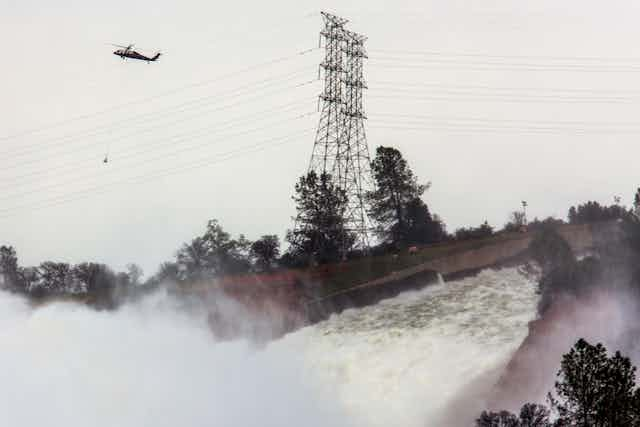Disaster was narrowly averted after America’s tallest dam threatened to release a deluge of water over thousands of homes on February 12. Dramatic scenes of water cascading from the Oroville dam emerged after a hole the size of a football field appeared in the spillway floor, allowing water to rip through its foundations and compromise the whole structure. Authorities ordered 180,000 people to evacuate while the water level was lowered to relieve pressure on the damaged spillway. But 48 hours later, the immediate danger had passed and residents were allowed to return home.
This near catastrophe is just the latest symptom of the chronic ill-health of America’s civil infrastructure, which has suffered from decades of under-investment and neglect. But the Oroville dam crisis could provide an unexpected opportunity for the new Trump administration to take on both problems – and win.
Winning is important to the US president, Donald Trump. This is not in dispute. He has built his name, his fame and his entire presidential campaign on being seen to be a winner. In office, he has been quick to reject situations where there is no easy win in sight: from his opposition to the environmental lobby, to his dislike of multilateral trade deals and his “shut up shop” attitude on migration.
But when it comes to infrastructure, the win is clear to see: stuff is broken, stuff can be fixed by good, honest blue-collar workers driving proper US-made machines. These things can be paid for using money – and money is what Trump knows about. New roads, new jobs, a New Deal even – these all look like wins for a relentlessly ambitious president.
What’s the damage?
But renewing the nation’s failing infrastructure is not a simple process, as successive White House administrations have found. Up to US$1 trillion is required to repair or replace ageing dams, bridges, highways and all the other components that support modern civilisation. Where to source the money has been a subject of political wrangling for decades.
Arguments between state and federal administrations, fuelled by political in-fighting and lobbyists – including environmentalists who are opposed to big infrastructure on principle – have all contributed to the stasis. But with a new strategy, Trump might just be able to score a big win where other presidents have lost out.
For water infrastructure, such as Oroville dam, perhaps the most obvious part of the problem is the weather. After five years of extreme drought, this winter has brought record rainfalls. Just prior to the crisis, the Oroville reservoir and others like it were at more than 150% of their normal capacity.

Under these conditions, every storm becomes a challenge for water resource engineers. But what has this got to do with Trump’s infrastructure promise? Year-on-year variations in seasonal weather are highly unpredictable. But in the longer term, atmospheric rivers (a key factor in Californian climate) and similar extreme weather events are robustly predicted to increase in frequency as the global climate warms. The strong balance of scientific evidence and opinion suggests that greenhouse gas emitters worldwide are at least partially responsible: particularly in the US and China, which together generate a third of world emissions
The denier’s dilemma
This presents Trump the climate change denier with a dilemma. To get the win on infrastructure, he needs money. To get the money in a reasonable time frame, he will need corporate investors who are prepared to cut through the political deadlock. But investors require incentives to channel funds into long-term public works, for which Trump will claim the bulk of the credit. And market economics suggests that if there was any money in it for them, this would already be happening.
The Oroville dam, though, demonstrates that some of the largest imminent threats to infrastructure will increase through climate change. If Trump could take an executive decision to shift his position on that – surely not hard for someone who deals so readily in “alternative facts” – then a pathway to the win could open up.

Apportioning blame for carbon emissions could bolster his case for tariffs and other sanctions on Chinese imports. A similar economic stick for domestic polluters would be less palatable, but the money raised could be used to provide corporations with financial incentives to invest in maintaining infrastructure, expanding renewables and adopting green, energy-efficient technology. All these projects promise long-term gains for US businesses and jobs, if only the initial inertia could be overcome. Carbon reduction tariffs, linked specifically to infrastructure renewal incentives, could provide that vital momentum.
Such ideas have been around for decades: environmental thinkers including Paul Hawken and Amory Lovins espouse the notion of “natural capitalism” – a market-driven economics which centres on the value of natural resources. The Oroville dam provides compelling evidence of the hard economic costs of inaction on infrastructure.
Accepting man-made climate change could provide Trump with a chance to deliver on one of his major campaign promises, change the face of capitalism and perhaps even save the world along the way. Doesn’t that look like a win?

